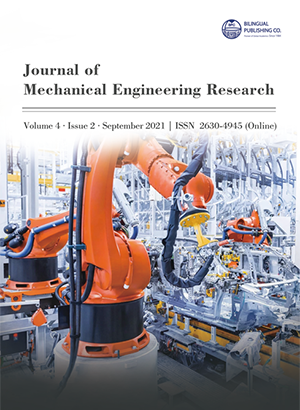Analysis of Autogenous Laser Welding in Low Carbon and Large Thickness Steel
DOI:
https://doi.org/10.30564/jmer.v4i2.3381Abstract
With the use of laser welding, it is possible to join different steel, with different thicknesses, with or without the action of protective layers. The quality of laser radiation makes it possible to get certain characteristics that are impossible to get by other processes, such as high welding speeds, less metallurgical effects suffered by the heat-affected zone (ZAC), and this process also does not require filler metal, therefore it is free from possible contamination. Combined with traditional welding methods, laser welding produces narrower weld beads, allowing for better prevention of corrosion and thermal distortions. Although the process already has high industrial knowledge, some random defects, such as porosities and inconsistencies, are still found. This work presents a systematic study to determine the influence of laser welding parameters and how these parameters influence welding defects. For this, the experimental part was carried out in the welding laboratory - LABSOLDA, of the Federal University of Santa Catarina - UFSC, during the laser welding processes, a welding speed of 2.4 m/min was reached. For this experiment, argon was used as a shielding gas and 1020 steel was used as the base material.
Keywords:
Autogenous LASER welding, Welding of thick joints, Keyhole stability.References
[1] MAIMAN, T.H. Simulated optical radiation in ruby. Nature, v. 187, p. 493-494, 1960.
[2] STEEN, W. M. Laser material processing, SpringerVerlag, ISBN 1852336986. 2005.
[3] MENDEZ, P. F.; EAGAR, T. W. Penetration and defect formation in high-current arc welding. Welding Journal, p. 296- 306, 2003.
[4] LEIDINGER, D., et al. Improved manufacturing processes with high power lasers. Infrared Phys. Technol. vol. 36, No. 1, Great Britain, 251-266 p ,1995.
[5] LADARIO, P. F et.al A study of the laser welding process of automotive blanks, with and without coating, in the industrial environment aiming at incremental improvements and cost reduction. Pág. 02, 2009.
[6] CARVALHO S. M. Study of laser and TIG weldability of commercially pure grade 2 titanium used in aircraft pneumatic systems. Thesis - USP, Lorena, Brazil,2012.
[7] SAUCEDO, F. V., et al. Industrial Laser solutions for manufacturing, 2016. [Online]. Disponível em: [Acesso em: 10- Out-2016].
[8] BELFORTE, D. Tailor blank welding in Europe. Industrial Laser Solutions, USA, v. March, 2002.
[9] HITZ, C. B., EWING, J. J., HECHT J. Introduction to Laser Technology. 4. ed. Piscataway: Wiley-IEEE Press, 2012. 312 p.
[10] ABNT-Brazilian Association of Technical Standards - NBR NM-87-2000 - Carbon Steel and Alloys for Mechanical Construction - Designation and chemical composition. Available in: https://vdocuments.com. br/nbr-nm-87-2000-aco-carbono-e-ligados-para-construcao-mecanica-designacao.html.
[11] BUEHLER SUM-MET - The Science Behind Materials Preparation. ISBN 0-9752898-0-2, 2004.
[12] ASTM A370-10. Standard Test Methods and Definitions for Mechanical Testing of Steel Products. Available in: https://www.astm.org/Standards/A370.htm.
[13] API Standard 1104, 21st Edition is the industry standard for welding practices. Available in: https://pdfcoffee.com/api-1104-05bilinguecorpo-da-norma-pdffree.html.
[14] A370-20 Standard Test Methods and Definitions for Mechanical Testing of Steel Products yield - Tension test - Charpy impact test/ Izod. Available in: https:// www.astm.org/DATABASE.CART/HISTORICAL/ A370-17.htm.
[15] ASTM E92-82 - Standard Test Method for Vickers Hardness of Metallic Materials. Available in: https:// www.astm.org/Standards/E92.htm.
Downloads
Issue
Article Type
License
Copyright © 2021 Daniel Kohls, Carlos Enrique Ninõ Bohorquez, Enori Gemilli, Majorie Anacleto Bernardo

This is an open access article under the Creative Commons Attribution-NonCommercial 4.0 International (CC BY-NC 4.0) License.




 Daniel Kohls
Daniel Kohls

